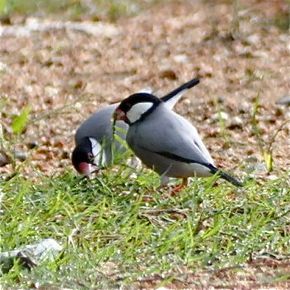On 30th March 2010, Dato’ Dr Amar-Singh HSS encountered an adult pair of Java Sparrows (Lonchura oryzivora) – collecting nesting material in Ipoh City, Perak, Malaysia.
“A flock of feral Java Sparrows have made their home here for many years, now threatened by development,” says Amar. “Saw a pair on the ground (below left), at first thought they were feeding but looks like they were collecting nesting material for their home in the limestone hills nearby.”
Flocks of these feral sparrows nest in the limestone hills surrounding the city (above right). They usually nest in cavities found on the bare cliffs using dry grass collected from around the city. Unfortunately about 40% of these fascinating hills are being actively exploited for their limestone.
Java Sparrow has its origin in birds deliberately released in and around urban centres. It was first reported in Singapore in the 1840s and in Malaysia’s Kuala Lumpur in the 1960s. Ipoh’s population appears to be flourishing because of the limestone hills, but now declining due to development.
Reference:
Wells, D.R., 2007. The birds of the Thai-Malay Peninsular. Vol. II, Passerines. Christopher Helm, London. 800 pp.











3 Responses
These birds are used in the fortune-telling business here in Singapore. It is a dying trade though. I used to pass by some of these limestone hills on my frequent bus route to Penang and as always, feeling very sad at how they are exploited and destroyed irreversibly. You know, these hills have very unique flora different from other lowland forest types. In fact, many plants are endemic in Malaysia. Such a loss… 40% you say? Thanks for the information.
Male Java sparrows sometimes sing inside a cage housed with other pet birds, notwithstanding that they are not excellent singers when compared with the oriental white eyes or Chinese singing thrushes(hwa mei).
More importantly, they can be easily tamed.
Blessings.